The Magneto-Natural Convection Flow of a Micropolar Hybrid Nanofluid over a Vertical Plate Saturated in a Porous Medium
Abstract
1. Introduction
2. Problem Formulation
3. Adaptive Chebyshev Differential Quadrature Method
4. Results and Discussion
5. Conclusions
- -
- As the micropolar parameter boosted the skin friction coefficient, the Nusselt number diminished with the IHG and WIHG cases.
- -
- Both the skin friction coefficient and the Nusselt number magnified with upsurging in the Darcy number whilst the opposite impact occurred with the growth in the micro-rotation parameter.
- -
- The thermal radiation parameter contributed to ensuing that the skin friction coefficients and heat transport rates were ever-growing.
- -
- The skin friction coefficient improved and the Nusselt number declined by swelling the values of the nanoparticle volume fraction.
- -
- Both the skin friction coefficient and the Nusselt number declined significantly by strengthening the magnetic force.
- -
- A growth in the suction parameter yielded a sufficient enhancement in the Nusselt number and the skin friction coefficient with the IHG and WIHG cases.
Author Contributions
Funding
Institutional Review Board Statement
Informed Consent Statement
Data Availability Statement
Acknowledgments
Conflicts of Interest
Correction Statement
Nomenclature
| Magnetic field strength | |
| Heat capacity | |
| Darcy number | |
| Dimensionless angular velocity | |
| Gravity | |
| Grashof number | |
| Density of micro-inertia | |
| Permeability | |
| Magnetic parameter | |
| Dimensional angular velocity | |
| Micro-rotation parameter | |
| Prandtl number | |
| Radiation heat flux | |
| Heat generation | |
| Micropolar parameter | |
| Radiation parameter | |
| Dimensional temperature | |
| Velocity components | |
| Dimensional coordinates | |
| Greek symbols | |
| Density of the fluid | |
| Viscosity of spin gradient | |
| σ* | Stefan–Boltzmann constant |
| κ* | Coefficients of mean absorption |
| Solid volume fraction | |
| Coefficient conductivity for electricity | |
| Stream function | |
| Effective dynamic viscosity | |
| Volumetric expansion coefficient | |
| Dimensionless temperature | |
| Subscripts | |
| Conditions at the surface | |
| Base fluid | |
| Conditions in the free stream | |
| Nanofluid | |
| Hybrid nanofluid | |
References
- Nield, D.A.; Bejan, A. Convection in Porous Media; Springer: New York, NY, USA, 2013. [Google Scholar]
- Ingham, D.B.; Pop, I. Transport Phenomena in Porous Media III; Elsevier: Oxford, UK, 2005. [Google Scholar]
- Vafai, K. Porous Media: Applications in Biological Systems and Biotechnology; CRC Press: Tokyo, Japan, 2010. [Google Scholar]
- Choi, S.U.S. Enhancing thermal conductivity of fluids with nanoparticle, Developments and Applications of Non-Newtonian Flows. ASME FED 1995, 231, 99–105. [Google Scholar]
- Eastman, J.A.; Choi, U.S.; Li, S.; Thompson, L.J.; Lee, S. Enhanced Thermal Conductivity through the Development of Nanofluids. MRS Proc. 1996, 457, 3–11. [Google Scholar] [CrossRef]
- Buongiorno, J. Convective Transport in Nanofluids. J. Heat Transf. 2006, 128, 240–250. [Google Scholar] [CrossRef]
- Chamkha, A.; Rashad, A. Natural convection from a vertical permeable cone in a nanofluid saturated porous media for uniform heat and nanoparticles volume fraction fluxes. Int. J. Numer. Methods Heat Fluid Flow 2012, 22, 1073–1085. [Google Scholar] [CrossRef]
- Chamkha, A.J.; Rashad, A.M.; Aly, A.M. Transient natural convection flow of a nanofluid over a vertical cylinder. Meccanica 2012, 48, 71–81. [Google Scholar] [CrossRef]
- Rashad, A.M. Natural convection boundary layer flow along a sphere embedded in a porous medium filled with a nanofluid. Lat. Am. Appl. Res. 2014, 44, 149–157. [Google Scholar]
- El-Kabeir, S.M.M.; Chamkha, A.J.; Rashad, A.M. The effect of thermal radiation on non-darcy free convection from a vertical cylinder embedded in a nanofluid porous media. J. Porous Media 2014, 17, 269–278. [Google Scholar] [CrossRef]
- Chamkha, A.J.; Rashad, A.M.; Reddy, C.R.; Murthy, P.V.S.N. Effect of suction/injection on free convection along a vertical plate in a nanofluid saturated non-Darcy porous medium with internal heat generation. Indian J. Pure Appl. Math. 2014, 45, 321–342. [Google Scholar] [CrossRef]
- Rashad, A. Impact of thermal radiation on MHD slip flow of a ferrofluid over a non-isothermal wedge. J. Magn. Magn. Mater. 2017, 422, 25–31. [Google Scholar] [CrossRef]
- Sandeep, N.; Chamkha, A.J.; Animasaun, I.L. Numerical exploration of magnetohydrodynamic nanofluid flow suspended with magnetite nanoparticles. J. Braz. Soc. Mech. Sci. Eng. 2017, 39, 3635–3644. [Google Scholar] [CrossRef]
- Dogonchi, A.; Sheremet, M.A.; Pop, I.; Ganji, D. MHD natural convection of Cu/H2O nanofluid in a horizontal semi-cylinder with a local triangular heater. Int. J. Numer. Methods Heat Fluid Flow 2018, 28, 2979–2996. [Google Scholar] [CrossRef]
- El-Zahar, E.R.; Rashad, A.M.; Seddek, L.F. The Impact of Sinusoidal Surface Temperature on the Natural Convective Flow of a Ferrofluid along a Vertical Plate. Mathematics 2019, 7, 1014. [Google Scholar] [CrossRef]
- Nabwey, H.A.; Khan, W.A.; Rashad, A.M. Lie Group Analysis of Unsteady Flow of Kerosene/Cobalt Ferrofluid Past A Radiated Stretching Surface with Navier Slip and Convective Heating. Mathematics 2020, 8, 826. [Google Scholar] [CrossRef]
- Ghadikolaei, S.; Yassari, M.; Sadeghi, H.; Hosseinzadeh, K.; Ganji, D. Investigation on thermophysical properties of Tio2–Cu/H2O hybrid nanofluid transport dependent on shape factor in MHD stagnation point flow. Powder Technol. 2017, 322, 428–438. [Google Scholar] [CrossRef]
- El-Kabeir, S.M.M.; El-Zahar, E.R.; Modather, M.; Gorla, R.S.R.; Rashad, A.M. Unsteady MHD slip flow of a ferrofluid over an impulsively stretched vertical surface. AIP Adv. 2019, 9, 045112. [Google Scholar] [CrossRef]
- Wei, B.; Zou, C.; Yuan, X.; Li, X. Thermo-physical property evaluation of diathermic oil based hybrid nanofluids for heat transfer applications. Int. J. Heat Mass Transf. 2017, 107, 281–287. [Google Scholar] [CrossRef]
- Suresh, S.; Venkitaraj, K.P.; Selvakumar, P.; Chandrasekar, M. Synthesis of Al2O3-Cu/Water Hybrid Water-Based Suspensions Using Two Step Method and Its Thermo Physical Properties. Colloids Surf. A Physicochem. Eng. Asp. 2011, 388, 41–48. [Google Scholar] [CrossRef]
- Ho, C.; Huang, J.; Tsai, P.; Yang, Y. On laminar convective cooling performance of hybrid water-based suspensions of Al2O3 nanoparticles and MEPCM particles in a circular tube. Int. J. Heat Mass Transf. 2011, 54, 2397–2407. [Google Scholar] [CrossRef]
- Eringen, A.C. Theory of micropolar fluid. J. Math. Mech. 1966, 16, 1–18. [Google Scholar] [CrossRef]
- Ariman, T.; Turk, M.A.; Sylvester, N.D. Microcontinuum fluid mechanics—A review. Int. J. Eng. Sci. 1973, 11, 905–930. [Google Scholar] [CrossRef]
- Ahuja, A.S. Augmentation of heat transport in laminar flow of polystyrene suspensions. I. Experiments and results. J. Appl. Phys. 1975, 46, 3408–3416. [Google Scholar] [CrossRef]
- Bourantas, G.; Loukopoulos, V. MHD natural-convection flow in an inclined square enclosure filled with a micropolar-nanofluid. Int. J. Heat Mass Transf. 2014, 79, 930–944. [Google Scholar] [CrossRef]
- Bourantas, G.; Loukopoulos, V. Modeling the natural convective flow of micropolar nanofluids. Int. J. Heat Mass Transf. 2014, 68, 35–41. [Google Scholar] [CrossRef]
- Rashad, A.M.; Khan, W.A.; El-Kabeir, S.M.M.; El-Hakiem, A.M.A. Mixed Convective Flow of Micropolar Nanofluid across a Horizontal Cylinder in Saturated Porous Medium. Appl. Sci. 2019, 9, 5241. [Google Scholar] [CrossRef]
- Rashad, A.M.; Khan, W.; Tlili, I.; EL-Hakiem, A.M.A. Unsteady slip flow of a micropolar nanofluid over an impulsively stretched vertical surface. Indian J. Pure Appl. Phys. 2019, 57, 773–782. [Google Scholar]
- Suresh, K.; Venkitaraj, P.; Chandrasekar, S.M. Effect of Al2O3-Cu/water hybrid nanofluid in heat transfer. Exp. Therm. Fluid Sci. 2012, 38, 54–60. [Google Scholar] [CrossRef]
- Rashad, A.M.; Chamkha, A.J.; Ismael, M.; Salah, T. Magnetohydrodynamics natural convection in a triangular cavity flled with a Cu-Al2O3/Water hybrid nanofuid with localized heating from below and internal heat generation. J. Heat Transf. 2018, 140, 072502-13. [Google Scholar] [CrossRef]
- Mahdy, A.; Nabwey, H.A. Transient flow of micropolar dusty hybrid nanofluid loaded with Fe3O4-Ag nanoparticles through a porous stretching sheet have been studied. Results Phys. 2021, 21, 1–11. [Google Scholar]
- EL-Zahar, E.R.; Rashad, A.M.; Saad, W.; Seddek, L.F. Magneto-Hybrid Nanofuids Flow via Mixed Convection past a Radiative Circular Cylinder. Sci. Rep. 2020, 10, 10494. [Google Scholar] [CrossRef] [PubMed]
- El-Kabeir, S.; Rashad, A.; Khan, W.; Abdelrahman, Z.M. Micropolar ferrofluid flow via natural convective about a radiative isoflux sphere. Adv. Mech. Eng. 2021, 13, 1–10. [Google Scholar] [CrossRef]
- Ferdows, M.; Liu, D. Natural convective flow of a magneto-micropolar fluid along a vertical plate. Propuls. Power Res. 2018, 7, 43–51. [Google Scholar] [CrossRef]
- Jena, S.K.; Mathur, M.N. Similarity solutions for laminar free convective flow of a thermomicropolar fluid past a non isothermal vertical plate. Int. J. Eng. Sci. 1981, 19, 1431–1439. [Google Scholar] [CrossRef]
- Ahmadi, G. Self-similar solution of incompressible micropolar boundary layer flow over a semi-infinite plate. Int. J. Eng. Sci. 1976, 14, 639–646. [Google Scholar] [CrossRef]
- Peddieson, J. An application of the micropolar fluid model to the calculation of a turbulent shear flow. Int. J. Eng. Sci. 1972, 10, 23–32. [Google Scholar] [CrossRef]
- Ho, C.; Huang, J.; Tsai, P.; Yang, Y. Preparation and properties of hybrid water-based suspension of Al2O3 nanoparticles and MEPCM particles as functional forced convection fluid. Int. Commun. Heat Mass Transf. 2010, 37, 490–494. [Google Scholar] [CrossRef]
- Ho, C.; Liu, W.; Chang, Y.; Lin, C. Natural convection heat transfer of alumina-water nanofluid in vertical square enclosures: An experimental study. Int. J. Therm. Sci. 2010, 49, 1345–1353. [Google Scholar] [CrossRef]
- Bert, C.W.; Malik, M. Differential Quadrature Method in Computational Mechanics: A Review. Appl. Mech. Rev. 1996, 49, 1–28. [Google Scholar] [CrossRef]
- Shu, C. Differential Quadrature and Its Application in Engineering; Springer Science and Business Media LLC: Berlin/Heidelberg, Germany, 2000. [Google Scholar]
- Zong, Z.; Zhang, Y. Advanced Differential Quadrature Methods; Chapman and Hall/CRC: London, UK, 2009. [Google Scholar]
- Jiwari, R.; Gupta, R.; Kumar, V. Polynomial differential quadrature method for numerical solutions of the generalized Fitzhugh–Nagumo equation with time-dependent coefficients. Ain Shams Eng. J. 2014, 5, 1343–1350. [Google Scholar] [CrossRef]
- Korkmaz, A.; Dag, I. Polynomial based differential quadrature method for numerical solution of nonlinear Burgers’ equation. J. Frankl. Inst. 2011, 348, 2863–2875. [Google Scholar] [CrossRef]
- Mohammed, O.H.; Saeed, M.A. Numerical solution of thin plates problem via differential quadrature method using G-spline. J. King Saud Univ. Sci. 2019, 31, 209–214. [Google Scholar] [CrossRef]
- Ragb, O.; Seddek, L.; Matbuly, M. Iterative differential quadrature solutions for Bratu problem. Comput. Math. Appl. 2017, 74, 249–257. [Google Scholar] [CrossRef]
- Tang, T.; Trummer, M.R. Boundary Layer Resolving Pseudospectral Methods for Singular Perturbation Problems. SIAM J. Sci. Comput. 1996, 17, 430–438. [Google Scholar] [CrossRef]
- Chen, S.; Wang, Y.; Wu, X. Rational Spectral Collocation Method for a Coupled System of Singularly Perturbed Boundary Value Problems. J. Comput. Math. 2011, 29, 458–473. [Google Scholar] [CrossRef]
- Tee, T.W.; Trefethen, L.N. A Rational Spectral Collocation Method with Adaptively Transformed Chebyshev Grid Points. SIAM J. Sci. Comput. 2006, 28, 1798–1811. [Google Scholar] [CrossRef]
- Al-Juaydi, H.S. On Approximate Solutions of Singular Perturbation Boundary Value Problems. Master’s Thesis, PSAU University, Al-Kharj, Saudi Arabia, 2021. (Unpublished). [Google Scholar]
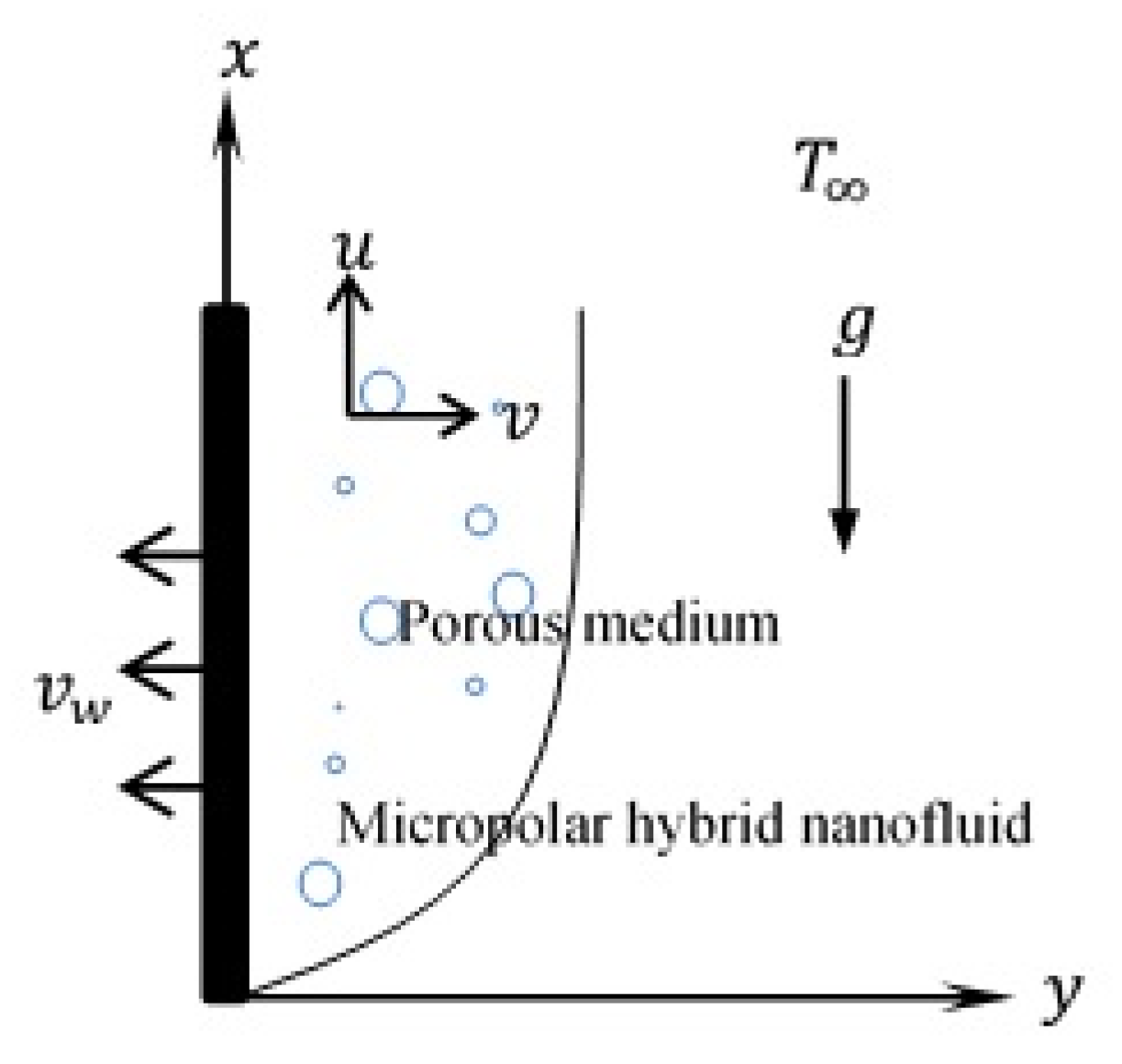
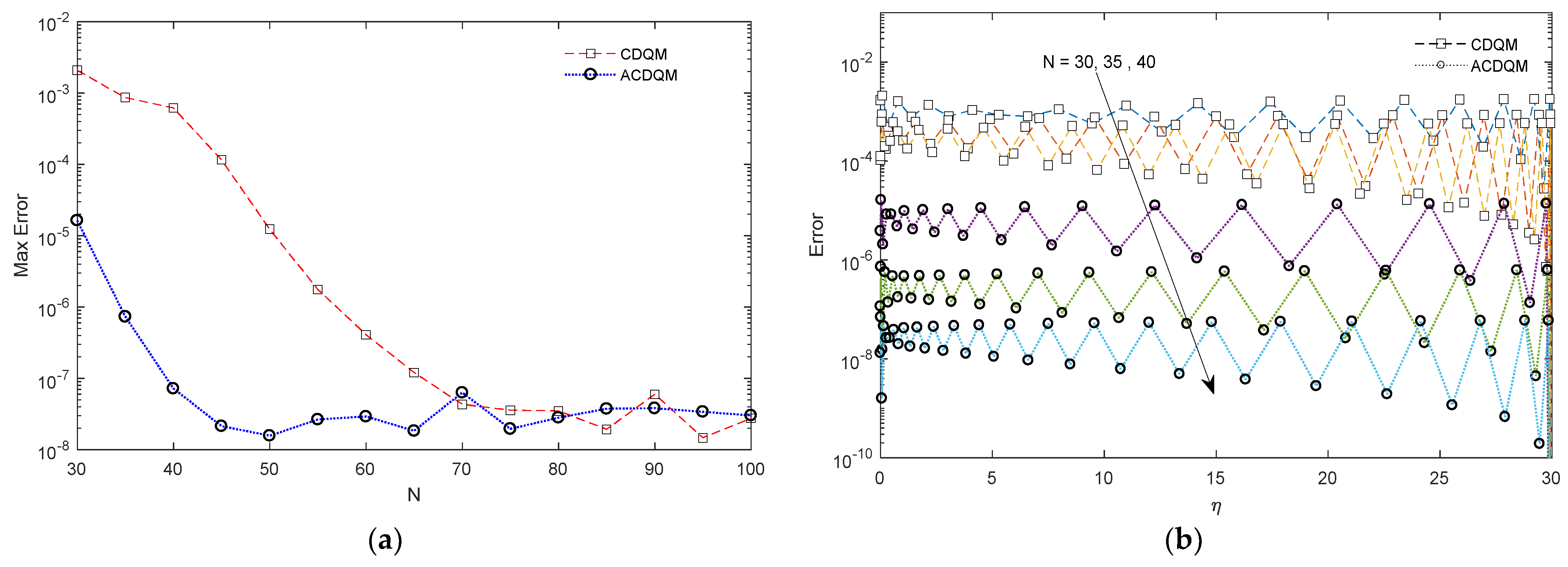
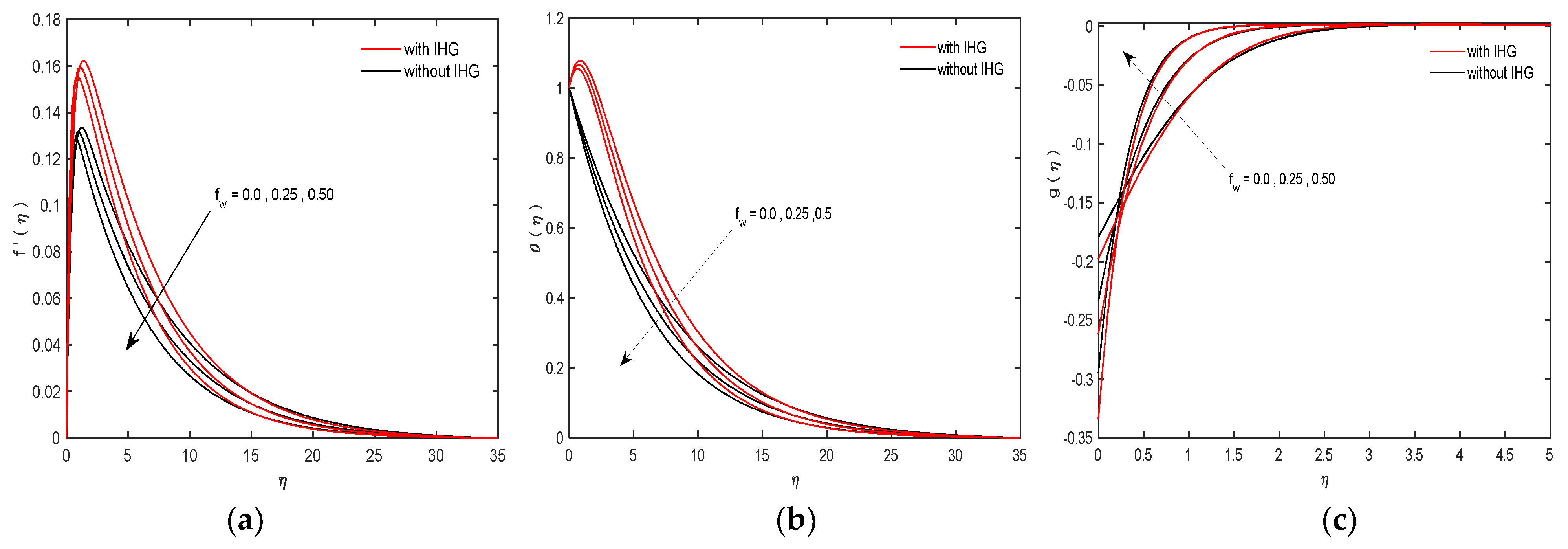
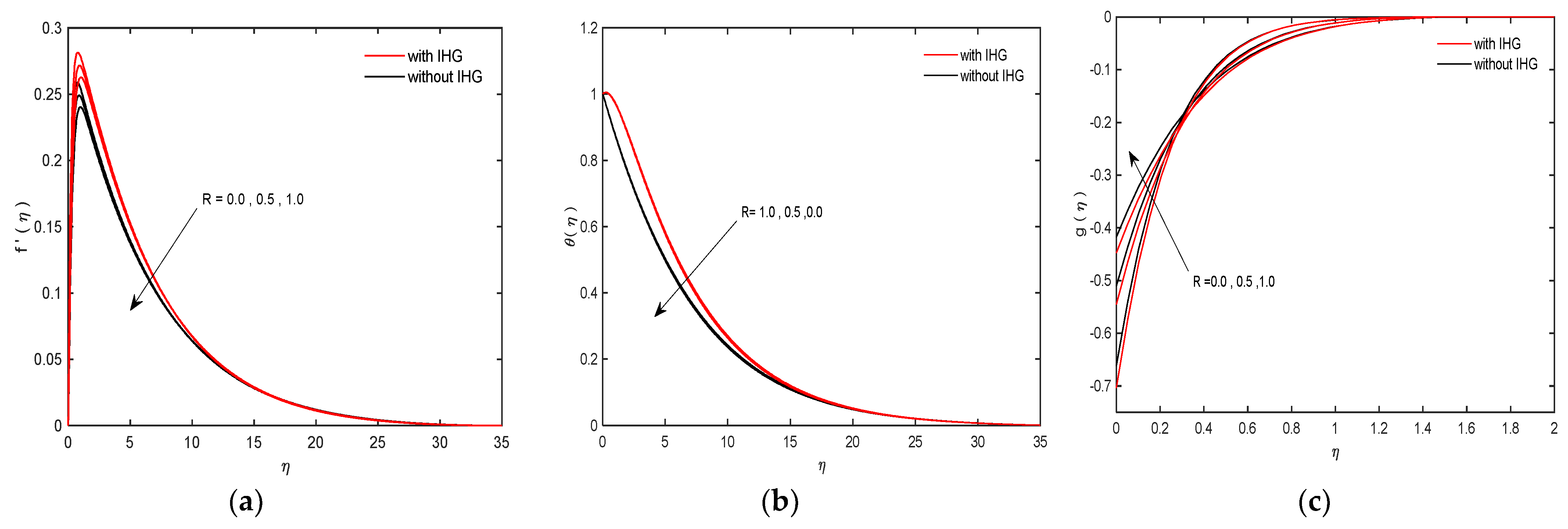

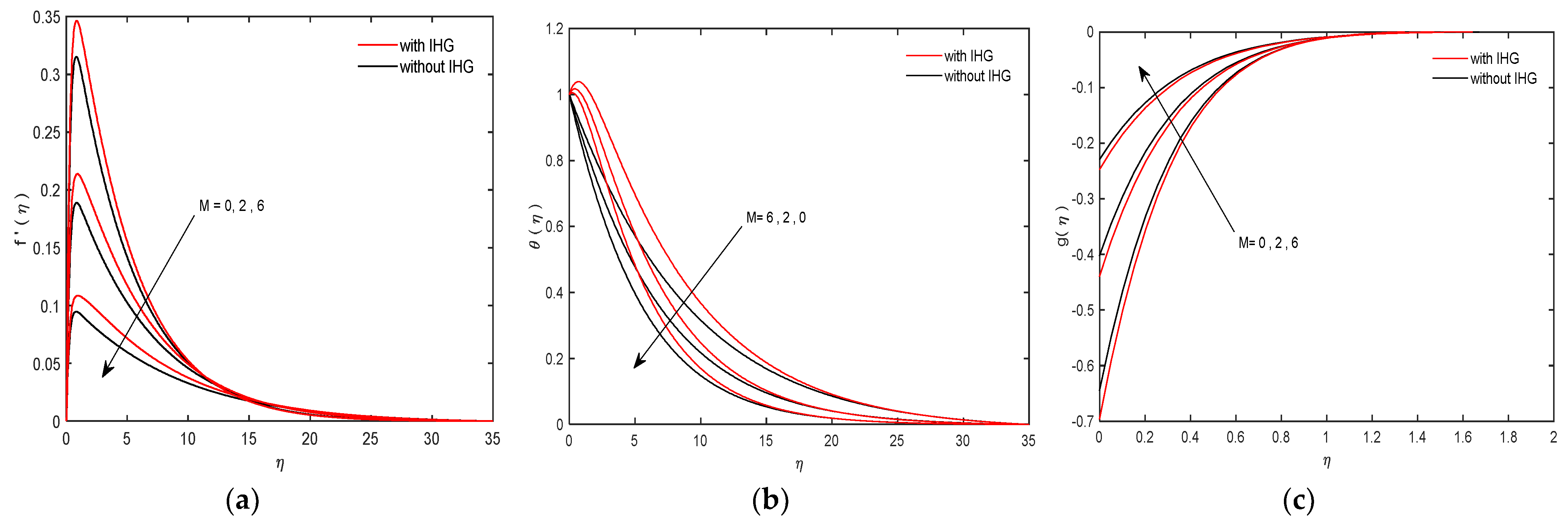



| Thermophysical Properties | H2O | Al2O3 | Cu |
|---|---|---|---|
| 1.67 | |||
| Ferdows et al. [33] | Present Study | |||||||
|---|---|---|---|---|---|---|---|---|
| IHG | WHG | IHG | WIHG | IHG | WIHG | IHG | WIHG | |
| 0 | 0.9564 | 0.7464 | −0.3486 | 0.402 | 0.9564 | 0.7464 | −0.3486 | 0.4020 |
| 0.25 | 0.879 | 0.6804 | −0.353 | 0.3991 | 0.8791 | 0.6804 | −0.3531 | 0.3991 |
| 0.5 | 0.8169 | 0.6278 | −0.3571 | 0.3963 | 0.8169 | 0.6278 | −0.3570 | 0.3963 |
| 1 | M | n | ||||||||
|---|---|---|---|---|---|---|---|---|---|---|
| IHG | WIHG | IHG | WIHG | |||||||
| 0 | 2 | 0.5 | 0.5 | 1 | 0.1 | 1 | 0.7237 | 0.6433 | −0.4505 | 0.4179 |
| 0.5 | 0.6788 | 0.5996 | −0.4807 | 0.3956 | ||||||
| 1 | 0.6438 | 0.5664 | −0.5061 | 0.3772 | ||||||
| 0.5 | 0 | 0.5 | 0.5 | 1 | 0.1 | 1 | 0.9542 | 0.8401 | −0.3963 | 0.4589 |
| 2 | 0.6788 | 0.5996 | −0.4807 | 0.3956 | ||||||
| 6 | 0.4395 | 0.3950 | −0.5761 | 0.3289 | ||||||
| 0.5 | 2 | 0 | 0.5 | 1 | 0.1 | 1 | 0.7313 | 0.6460 | −0.4833 | 0.3932 |
| 0.5 | 0.6788 | 0.5996 | −0.4807 | 0.3956 | ||||||
| 1 | 0.6070 | 0.5362 | −0.4771 | 0.3988 | ||||||
| 0.5 | 2 | 0.5 | 0 | 1 | 0.1 | 1 | 0.4023 | 0.3646 | −0.5544 | 0.2980 |
| 0.25 | 0.5314 | 0.4756 | −0.5194 | 0.3450 | ||||||
| 0.5 | 0.6788 | 0.5996 | −0.4807 | 0.3956 | ||||||
| 0.5 | 2 | 0.5 | 0.5 | 1 | 0.1 | 1 | 0.6788 | 0.5996 | −0.4807 | 0.3956 |
| 2 | 0.6686 | 0.6139 | −0.4250 | 0.4687 | ||||||
| 3 | 0.6639 | 0.6219 | −0.3737 | 0.5314 | ||||||
| 0.5 | 2 | 0.5 | 0.5 | 1 | 0.05 | 1 | 0.6760 | 0.5948 | −0.4698 | 0.3998 |
| 0.1 | 0.6788 | 0.5996 | −0.4807 | 0.3956 | ||||||
| 0.15 | 0.6797 | 0.6010 | −0.4925 | 0.3903 | ||||||
| 0.5 | 2 | 0.5 | 0.5 | 1 | 0.1 | 1 | 0.6788 | 0.5996 | −0.4807 | 0.3956 |
| 20 | 0.9187 | 0.8087 | −0.4060 | 0.4514 | ||||||
| 100 | 0.9325 | 0.8208 | −0.4022 | 0.4543 | ||||||
Publisher’s Note: MDPI stays neutral with regard to jurisdictional claims in published maps and institutional affiliations. |
© 2021 by the authors. Licensee MDPI, Basel, Switzerland. This article is an open access article distributed under the terms and conditions of the Creative Commons Attribution (CC BY) license (https://creativecommons.org/licenses/by/4.0/).
Share and Cite
Mahdy, A.; El-Zahar, E.R.; Rashad, A.M.; Saad, W.; Al-Juaydi, H.S. The Magneto-Natural Convection Flow of a Micropolar Hybrid Nanofluid over a Vertical Plate Saturated in a Porous Medium. Fluids 2021, 6, 202. https://doi.org/10.3390/fluids6060202
Mahdy A, El-Zahar ER, Rashad AM, Saad W, Al-Juaydi HS. The Magneto-Natural Convection Flow of a Micropolar Hybrid Nanofluid over a Vertical Plate Saturated in a Porous Medium. Fluids. 2021; 6(6):202. https://doi.org/10.3390/fluids6060202
Chicago/Turabian StyleMahdy, A., E. R. El-Zahar, A. M. Rashad, W. Saad, and H. S. Al-Juaydi. 2021. "The Magneto-Natural Convection Flow of a Micropolar Hybrid Nanofluid over a Vertical Plate Saturated in a Porous Medium" Fluids 6, no. 6: 202. https://doi.org/10.3390/fluids6060202
APA StyleMahdy, A., El-Zahar, E. R., Rashad, A. M., Saad, W., & Al-Juaydi, H. S. (2021). The Magneto-Natural Convection Flow of a Micropolar Hybrid Nanofluid over a Vertical Plate Saturated in a Porous Medium. Fluids, 6(6), 202. https://doi.org/10.3390/fluids6060202







